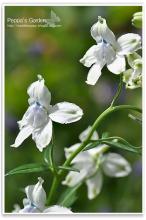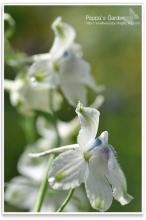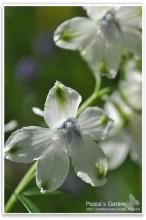Rare Oregon native. Three feet tall, grows in ordinary garden soil, can take drought in Summer. Seedlings vary in degree of blue coloration. These plants are three years old. Sets lots of seed.
Comments
Re: Delphinium pavonaceum
Gene, that's a very beautiful Delphinium. It seems that there are over 60 taxa of Delphinium in North America, largely untapped horticulturally. I did some research on the name, and there is some dispute over its status, Flora of North America and the USDA consider this a hybrid. Lots of interesting information out there on it, the most critical of which is this taxonomic entity is considered rare and threatened, both by habitat destruction and from genetic dilution from hybridization with other species.
Here are some good links. There is suggestion that since this is a white-flowered species, those with bluer shades or highlights are likely to be hybrids. Regardless, they're most beautiful.
http://www.centerforplantconservation.org/collection/cpc_viewprofile.asp...
"The white-flowered peacock larkspur appears to hybridize with a purple-flowered species and it is in danger of diluting the peacock larkspur's genetics until it is no longer is a distinct species (Goodrich 1983)"
http://www.oregon.gov/ODA/PLANT/CONSERVATION/profile_depa.shtml
The Flora of North America North of Mexico treats peacock larkspur as a hybrid between Delphinium menziesii ssp. pallidum and D. trolliifolium. "However, based on its unique morphology and fertile, self-sustaining populations, peacock larkspur is treated here as a distinct species (D. pavonaceum), following the Oregon Flora Project treatment of the taxon".
Flora of North America
Hybrids between Delphinium menziesii subsp. pallidum and D . trolliifolium have been named D . × pavonaceum
http://www.efloras.org/florataxon.aspx?flora_id=1&taxon_id=233500520
USDA follows suit and also considers this a hybrid taxon,
Delphinium ×pavonaceum Ewan (pro sp.) [menziesii × trolliifolium], the Peacock larkspur
http://plants.usda.gov/java/profile?symbol=DEPA4
Oregon Dept of Agriculture - Plant Division,
PDF on "Developing population density estimates for nine rare Willamette Valley prairie species"
http://www.oregon.gov/ODA/PLANT/CONSERVATION/docs/pdf/report_WV_densest.pdf
Re: Delphinium pavonaceum
Mark, most interesting!
Many new species of plants have arisen as interspecific hybrids either recently (postglacial times) or preglacial times. Sometimes the initial cross is followed by polyploidization that makes the specimen fertile.
Also species in harsh habitats with small populations benefit from being polyploid as this increases the amount of genetic diversity.
Re: Delphinium pavonaceum
Nice pictures, Gene!
Mine is blooming right now for the first time. It is still in a pot and I sowed the seeds which I got from the NARGS seed exchange two years ago. The blue markings on mine are a little bit lighter than yours; it's interesting to see the variation between plants.
Re: Delphinium pavonaceum
One thing I forgot to mention... I would love to thank whoever donated these seeds to the exchange! :)
Re: Delphinium pavonaceum
Saori, I'll be on the watch for this one (in the seed lists), what a beauty your plants are (I love white flowers with clear highlights) as well as the form seen in Gene's original post.




Same questions here: How does it tolerate slugs and do you have some seeds to spare ;)